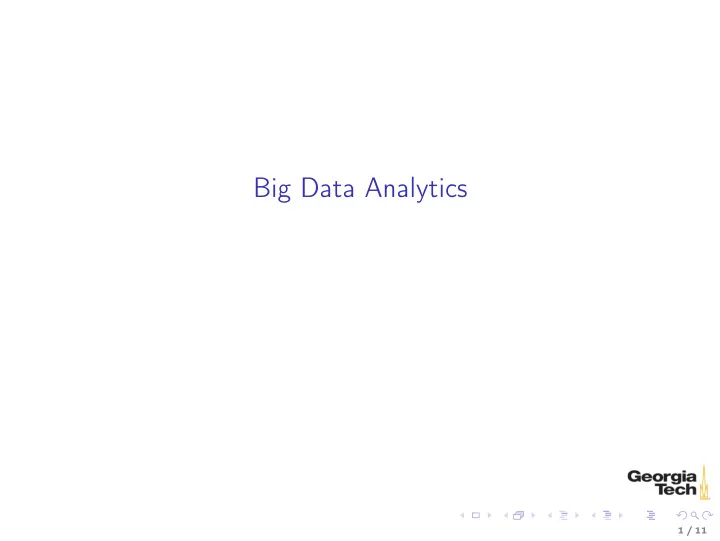

Big Data Analytics 1 / 11
What is Big Data? Caracterized by ◮ Volume ◮ No specific threshhold, but typically several gigabytes (10 9 ), terabytes (10 12 or petapbytes (10 15 ) ◮ Velocity – the data are generated quickly ◮ Facebook generates 600 TB of new data per day. 1 ◮ Variety – from multiple, often heterogeneous sources ◮ Variability – incomplete data, inconsistency within and between data sources ◮ Veracity – how can you trust the data you ingest? A good operative definition: a data set that may not fit on a single hard disk and/or requires parallel computation to process in a reasonable amount of time. (In practice many "big data" sets measure in the gigabytes, which might actually fit on a single modern disk.) 1 Pamela Vagata and Kevin Wilfong, Scaling the Facebook data warehouse to 300 PB 2 / 11
Applications of Big Data ◮ Web search ◮ Ad serving ◮ Multimedia analytics (image, video) ◮ Collaborative filtering (e.g., "customers who viewed this also viewed") ◮ Customer churn (identify customers likely to switch to a competitor in order to target special offers aimed at retention) ◮ Health care analytics ◮ Any sort of analytics application where the scale requires "big data" technology for reasonable performance. Big data processing is typically done in batch mode. A new paradigm, fast data, has recently emerged in which data are processed in real-time, often in combination with some batch-mode processing. We’ll focus on batch mode big data processing here, which is also typically a component of fast data systems. 3 / 11
Managing Big Data The characteristics of big data lead to two primary technical challenges: ◮ storage, and ◮ parallel processing. We’ll explore these challenges in the context of a ubiquitous industry-standard solution: the Hadoop scalable distributed computing platform. 4 / 11
The Hadoop Platform Hadoop is not a single software product, but an ecosystem of software tools. ◮ Core components: ◮ Common utilities that support the other Hadoop modules. ◮ Hadoop Distributed File System (HDFS™): A distributed file system that provides high-throughput access to application data. ◮ YARN (Yet Another Resource Manager): A framework for job scheduling and cluster resource management. ◮ MapReduce: A YARN-based system for parallel processing of large data sets. ◮ Add-ons and related projects: ◮ Cluster/Job Management: Amari, ZooKeeper ◮ Databases: Cassandra, HBase, Parquet ◮ Streaming engines (for fast data applications): Flink, Kafka, Spark Streaming ◮ Languages, libraries and compute engines: Pig, Hive, Mahout, Spark 5 / 11
The Hadoop Ecosystem 6 / 11
Installing Hadoop ◮ Single computer ◮ Cluster 7 / 11
HDFS Assumptions and Goals ◮ Hardware Failures will happen. Detection of faults and quick, automatic recovery from them is a core architectural goal of HDFS. ◮ Streaming Data Access – high-throughput rather than interactive use. Trade a few POSIX requirements to increase data throughput. ◮ Large Data Sets – tens of millions of large files (gigabytes to terabytes each) ◮ Simple Coherency Model – write-once-read-many. After creation, files can only be appended to or truncated. ◮ "Moving Computation is Cheaper than Moving Data" ◮ Portability Across Heterogeneous Hardware and Software Platforms 8 / 11
HDFS Architecture 2 2 http://hadoop.apache.org/docs/current/hadoop-project-dist/ hadoop-hdfs/HdfsDesign.html 9 / 11
MapReduce split - map - reduce 10 / 11
Example: Word Count Canonical example. 11 / 11
Recommend
More recommend